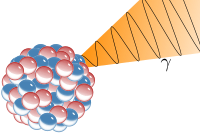
Photo from wikipedia
We study the pion-photon transition form factor (TFF) $F^{\gamma*\gamma\pi^0}(Q^2)$ using a state-of-the art implementation of light cone sum rules (LCSRs) within fixed-order QCD perturbation theory. The spectral density in the… Click to show full abstract
We study the pion-photon transition form factor (TFF) $F^{\gamma*\gamma\pi^0}(Q^2)$ using a state-of-the art implementation of light cone sum rules (LCSRs) within fixed-order QCD perturbation theory. The spectral density in the dispersion relation includes all currently known radiative corrections up to the next-to-next-to-leading-order (NNLO) and all twist contributions up to order six. Predictions for the TFF are obtained for various pion distribution amplitudes (DAs) of twist two, including two-loop evolution which accounts for heavy-quark mass thresholds. The influence of the main theoretical uncertainties is quantified in order to enable a more realistic comparison with the data. The characteristics of various pion DAs are analyzed in terms of the conformal coefficients $a_2$ and $a_4$ in comparison with the $1\sigma$ and $2\sigma$ error regions of the data and the most recent lattice constraints on $a_2$ with NLO and NNLO accuracy. Our results provide more stringent bounds on the variation of the pion DA and illuminate the corresponding asymptotic behavior of the calculated TFF.
Journal Title: Physical Review D
Year Published: 2020
Link to full text (if available)
Share on Social Media: Sign Up to like & get
recommendations!